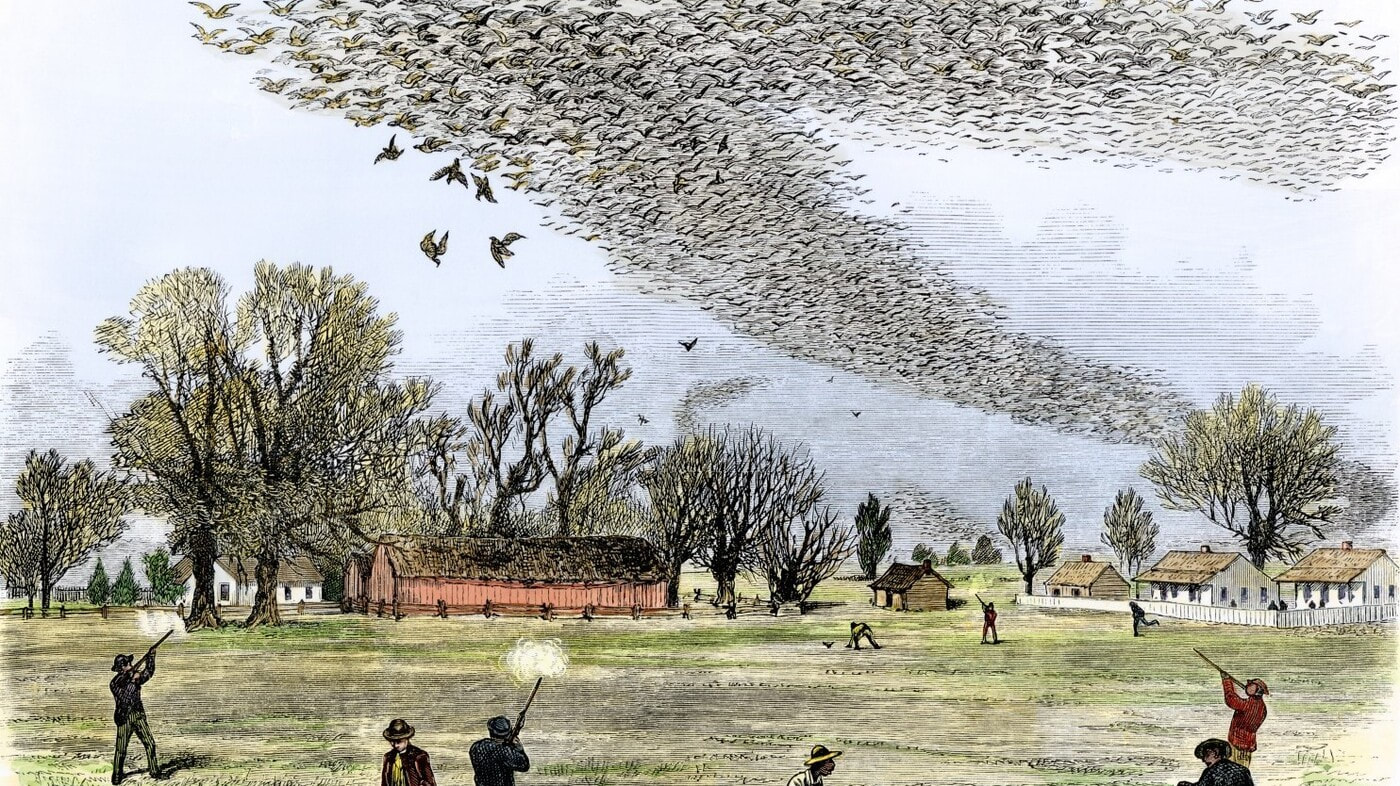This family story shared with Vintage Bentonville by William Morris. This story had been passed down through his family over the years. Hope you find it as interesting as I did.
George Craig told this story to his daughter Bennette Craig Germain around 1940 and she wrote it down in haste while he was talking. Her handwriting which was usually so clear was difficult to read. George Craig and his family waited move back to Bentonville from Cane Hill till 1871 when George was 9 years old. Their family left Bentonville early in the war when Jennison’s raiders burned down much of the town and killed men over 17 who might fight for the South. They spent the Civil War years in Cane Hill. 1871 happened to be one of the peak years for the Passenger Pigeon roosting in the Bentonville area.
In 1871 James Craig thought it was safe for his family to return to Bentonville from Cane Hill after the chaos created by the Civil War. As far as nine-year-old George Craig could tell it was just trading one ruined town for another.
One difference was the bushwhackers had broken the lower branches of every tree in the town square and in the orchard behind his house. When he asked why, he was told it wasn’t the bushwhackers; it was passenger pigeons. They were roosting in the orchards near Bentonville in tens of thousands. They rode out to see the damage.
There were so many of them their weight broke the thick lower branches of many of the trees. Other large trees were split in half as if a hurricane had gone through. Small trees were bent over entirely.
When coming in to roost at sundown it was like a dark cloud 2 to 3 miles away. Some were flying just off the ground and some were flying 3 hundred feet off the ground. At night the chatter of the roosting pigeons could be heard for miles. It sounded like a freight train running over a trestle a mile away.
In 1871 James Craig thought it was safe for his family to return to Bentonville from Cane Hill after the chaos created by the Civil War. As far as nine-year-old George Craig could tell it was just trading one ruined town for another.
One difference was the bushwhackers had broken the lower branches of every tree in the town square and in the orchard behind his house. When he asked why, he was told it wasn’t the bushwhackers; it was passenger pigeons. They were roosting in the orchards near Bentonville in tens of thousands. They rode out to see the damage.
There were so many of them their weight broke the thick lower branches of many of the trees. Other large trees were split in half as if a hurricane had gone through. Small trees were bent over entirely.
When coming in to roost at sundown it was like a dark cloud 2 to 3 miles away. Some were flying just off the ground and some were flying 3 hundred feet off the ground. At night the chatter of the roosting pigeons could be heard for miles. It sounded like a freight train running over a trestle a mile away.
The pigeons looked like turtle doves except they were 3 times larger — almost as large as the tame pigeons. They ate mostly white oak acorns and when cut open their stomachs were filled with them. Wild hogs had gotten fat from eating the smaller birds that fell from the trees and didn’t know how to fly.
Men hunted the birds at night while they were roosting. When the the birds were still warm, the hunters put their heads under their wings so when rigor mortis set in they remained that way. The hunters packed them in salt barrels and ship them to Saint Louis in carload lots. For a while it was quite an industry. A few hunters could kill 29 wagons of pigeons in a night. They could have had more but half way through the night their guns that were muzzle loaders became gummed up and they had to quit or risk the gun exploding in their faces.
The hunting kept on for 15 years then the pigeons suddenly disappeared. No one knew where they went. Some said they went to Patagonia. Others said a disease killed them. In any event they were completely gone 20 years later. It was such a mystery that the Saturday Evening Post tried to solve it by offering $1000 for a live or dead passenger pigeon. The reward was never claimed.
One of George Craig’s favorite books growing up was about Daniel Boone. Passengers pigeons were often referred to during his travels through Tennessee and Kentucky. Hunters favored them because they were big. Now they are completely gone.
Men hunted the birds at night while they were roosting. When the the birds were still warm, the hunters put their heads under their wings so when rigor mortis set in they remained that way. The hunters packed them in salt barrels and ship them to Saint Louis in carload lots. For a while it was quite an industry. A few hunters could kill 29 wagons of pigeons in a night. They could have had more but half way through the night their guns that were muzzle loaders became gummed up and they had to quit or risk the gun exploding in their faces.
The hunting kept on for 15 years then the pigeons suddenly disappeared. No one knew where they went. Some said they went to Patagonia. Others said a disease killed them. In any event they were completely gone 20 years later. It was such a mystery that the Saturday Evening Post tried to solve it by offering $1000 for a live or dead passenger pigeon. The reward was never claimed.
One of George Craig’s favorite books growing up was about Daniel Boone. Passengers pigeons were often referred to during his travels through Tennessee and Kentucky. Hunters favored them because they were big. Now they are completely gone.

